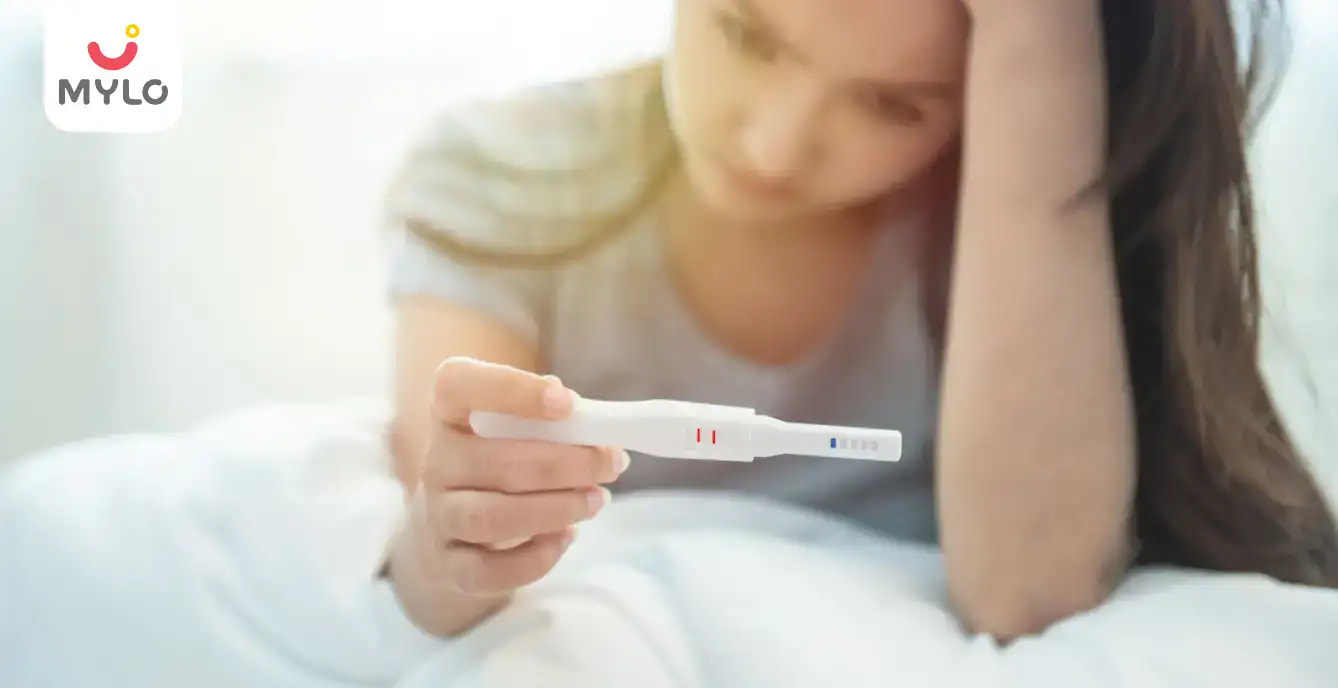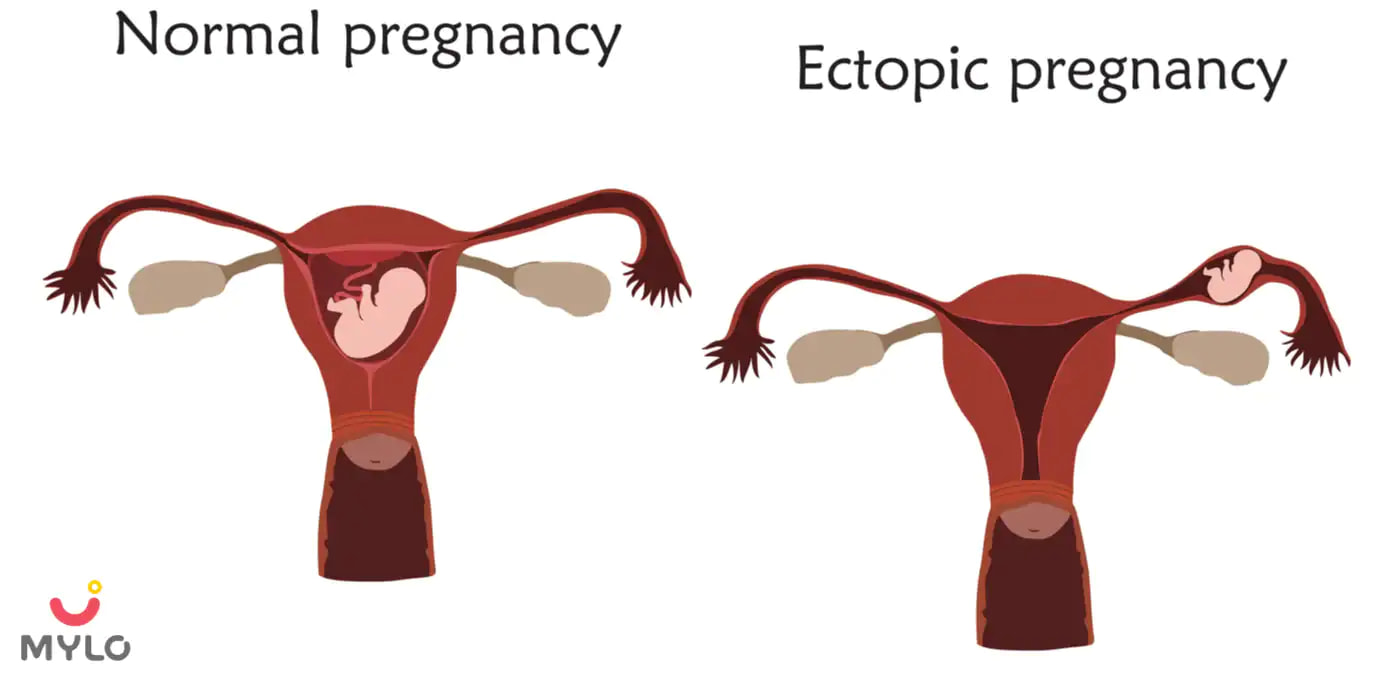Home

What are the Causes & Symptoms of a False Pregnancy?
In this Article

Pregnancy
What are the Causes & Symptoms of a False Pregnancy?
Updated on 3 November 2023
False Pregnancy or Pseudocyesis
False Pregnancy or Pseudocyesis is the belief that one is expecting a baby though the person is not carrying a child. It's also referred to as Phantom Pregnancy, Delusional Pregnancy or Hysterical Pregnancy. Females with false pregnancy have many, if not all, pregnancy symptoms, except one, i.e., the presence of an actual foetus in the womb.
In some rare cases, men too experience pregnancy-like symptoms called Couvade Syndrome or Sympathetic Pregnancy.
Causes of False Pregnancy
Various psychological and physical causes work in a loop and lead to the false belief that one is pregnant.
Psychological Causes that lead to false pregnancy
1) When a female experiences a strong desire to get pregnant, her body may produce pregnancy-like symptoms. The strong desire could be because of infertility, repeated miscarriages, delay in marriage or impending menopause. Such circumstances affect the hormone balance leading to the production of signs like a distended belly, enlarged breasts and, in some cases, the sensation of foetal movements. The female's brain believes those signs as pregnancy, and in reciprocal, hormones such as oestrogen and prolactin are released that lead to false pregnancy symptoms.
2) Poverty, a lack of education, childhood sexual abuse or relationship problems may trigger false pregnancy.
3) Depression resulting from any reason may lead a female to believe that she's pregnant. Antipsychotic drugs lead to increased prolactin levels that further induce pregnancy-like symptoms.
4) Other mental traumas like schizophrenia, personality disorders or mood disorders too may lead to the false perception that a lady is pregnant.
5) Stress, fear, anticipation or other emotional disturbances lead to increased central nervous system activity inducing pregnancy symptoms like distended abdomen, foetal movement sensation and assumed contraction.
Physical Causes that cause false pregnancy
1) Morbid obesity may mimic pregnancy.
2) Ovarian or Pituitary tumours lead to increased hormone production that further increases oestrogen and prolactin levels, leading to pregnancy-like symptoms.
3) Medical conditions like gallstones, abdominal tumours, constipation, tubal cysts may mimic pregnancy or produce pregnancy-like signs and symptoms.
False Positive Pregnancy Test leads the patient to believe that she's pregnant.
A false positive pregnancy test may lead the woman to believe that she's pregnant though she's not technically pregnant.
The chances of a false positive pregnancy test occur in the following cases.
1) Chemical Pregnancy
This happens when a fertilised egg or embryo can not implant in the uterine wall and grow.
2) Ectopic Pregnancy
When a fertilised egg implants in the fallopian tube or the cervix, ovary or somewhere in the abdominal cavity. This is an emergency that requires immediate medical intervention.
3) Recent miscarriage or abortion
In these cases, the hCG levels in the blood and urine are still on the upward trend as they normally rise to the sixth week. An ultrasound and subsequent D/C are needed in these cases.
4) User error
The self-use pregnancy test kits aren't foolproof. Not following the instructions properly might lead to false-positive pregnancy tests.
5) Medications
Females on fertility medications may get a false positive pregnancy test due to synthetic hCG in their blood.
6) Medical conditions like Molar Pregnancy, Urinary Tract Infections, Kidney Diseases or Ovarian or Pituitary cancer may lead to false-positive pregnancy tests.
Symptoms of False Pregnancy
The symptoms of False Pregnancy are the same as those pregnant.
1) Enlarged or distended abdomen. The navel stays inverted contrary to real pregnancy in which the navel gets everted.
2) Interruption of or delayed menstrual periods.
3) Enlarged and tender breasts accompanied by changes in nipples and in some cases, milk production too is present.
4) Sensation of foetal movements, which are peristaltic.
5) Weight gain.
6) Nausea and vomiting.
7) Increased urinary frequency.
8) Food cravings
9) The most important symptom that will confirm that the pregnancy is false is the report of abdominal ultrasound that will reveal the absence of the foetus.
10) A negative urine pregnancy test will also confirm that the pregnancy is false.
Treatment of False Pregnancy
The only and best way to convince a woman that she isn't pregnant is her ultrasound image which will confirm the absence of the foetus in the womb. Since a false pregnancy is just an illusion, no treatment and/or medication is required.
In case of menstrual irregularities, medication for the same will be needed.
When the false pregnancy is caused by other medical conditions like ovarian or pituitary tumours or morbid constipation, the relevant treatment will lead to the omission of the pregnancy-like symptoms.
In the case of women suffering from psychological instability and severe depression, consulting a psychotherapist will help solve the problem.
Summary
False Pregnancy is a rare phenomenon that may be confusing to the patient. When the patient is confronted with reality, it can be emotionally draining for her.
False-positive pregnancy tests are not the only issue. False-negative pregnancy tests are prevalent too that lead a woman to believe that she isn't pregnant though, in reality, she is.
The various causes that lead to false negative pregnancy test are:-
1)Test taken too early. Ideally, it's advised that the home kit test be taken one week after missing the periods.
2)The test results are checked too soon. The kit is provided with an instruction manual that mentions the time needed for the appearance of the second pink or blue line. If the woman doesn't wait for that much time, it will lead to a false negative pregnancy test.
3) Drinking too much water can lead to a false negative pregnancy test.
4) Incorrect use of pregnancy test kits.
5) Miscalculated menstrual cycle can lead to a false negative pregnancy test.
6)Diluted hCG levels can mislead the results.
It's advisable that whenever one experiences pregnancy signs and symptoms or takes a pregnancy home test, whatever the result, a laboratory test should be taken. In addition to that, being in touch with a medical expert is mandatory. The expertise of a doctor helps one clear the doubts and guides toward taking the right steps.
References
Ibekwe PC, Achor JU. (2008). Psychosocial and cultural aspects of pseudocyesis. www.ncbi.nlm.nih.gov



Written by
Priyanka Verma
Priyanka is an experienced editor & content writer with great attention to detail. Mother to an 11-year-old, she's a ski
Read MoreGet baby's diet chart, and growth tips

Related Articles
Related Questions
Hello frnds..still no pain...doctor said head fix nhi hua hai..bt vagina me pain hai aur back pain bhi... anyone having same issues??

Kon kon c chije aisi hai jo pregnancy mei gas acidity jalan karti hain... Koi btayega plz bcz mujhe aksar khane ke baad hi samagh aata hai ki is chij se gas acidity jalan ho gyi hai. Please share your knowledge

I am 13 week pregnancy. Anyone having Storione-xt tablet. It better to have morning or night ???

Hlo to be moms....i hv a query...in my 9.5 wk i feel body joint pain like in ankle, knee, wrist, shoulder, toes....pain intensity is high...i cnt sleep....what should i do pls help....cn i cosult my doc.

Influenza and boostrix injection kisiko laga hai kya 8 month pregnancy me and q lagta hai ye plz reply me

Related Topics
RECENTLY PUBLISHED ARTICLES
our most recent articles

Diet & Nutrition
গর্ভাবস্থায় আলুবোখরা: উপকারিতা ও ঝুঁকি | Prunes During Pregnancy: Benefits & Risks in Bengali

Diet & Nutrition
গর্ভাবস্থায় হিং | ঝুঁকি, সুবিধা এবং অন্যান্য চিকিৎসা | Hing During Pregnancy | Risks, Benefits & Other Treatments in Bengali

Women Specific Issues
স্তনের উপর সাদা দাগ: লক্ষণ, কারণ এবং চিকিৎসা | White Spots on Nipple: Causes, Symptoms, and Treatments in Bengali

Diet & Nutrition
গর্ভাবস্থায় পোহা: উপকারিতা, ধরণ এবং রেসিপি | Poha During Pregnancy: Benefits, Types & Recipes in Bengali

Diet & Nutrition
গর্ভাবস্থায় মাছ: উপকারিতা এবং ঝুঁকি | Fish In Pregnancy: Benefits and Risks in Bengali

Diet & Nutrition
গর্ভাবস্থায় রেড ওয়াইন: পার্শ্ব প্রতিক্রিয়া এবং নির্দেশিকা | Red Wine During Pregnancy: Side Effects & Guidelines in Bengali
- ইনার থাই চ্যাফিং: কারণ, উপসর্গ এবং চিকিৎসা | Inner Thigh Chafing: Causes, Symptoms & Treatment in Bengali
- গর্ভাবস্থায় ব্রাউন রাইস: উপকারিতা ও সতর্কতা | Brown Rice During Pregnancy: Benefits & Precautions in Bengali
- Velamentous Cord Insertion - Precautions, Results & Safety
- Unlock the Secret to Flawless Skin: 7 Must-Have Qualities in a Face Serum
- Unlock the Secret to Radiant Skin: How Vitamin C Serum Can Transform Your Complexion
- Gender No Bar: 10 Reasons Why Everyone Needs a Body Lotion
- Unlock the Secret to Radiant Skin How to Choose the Perfect Body Lotion for Your Skin Type
- Top 10 Reasons to Apply a Body Lotion After Every Bath
- Communication in Toddlers: Milestones & Activities
- How to Improve Vocabulary for Toddlers?
- A Comprehensive Guide to Understanding Placenta Accreta
- Vulvovaginitis in Toddlers Causes, Symptoms and Treatment
- A Comprehensive Guide to Understanding Cerebral Palsy in Children
- Bitter Taste in Mouth During Pregnancy: Understanding the Causes and Remedies


AWARDS AND RECOGNITION

Mylo wins Forbes D2C Disruptor award

Mylo wins The Economic Times Promising Brands 2022
AS SEEN IN
















- Mylo Care: Effective and science-backed personal care and wellness solutions for a joyful you.
- Mylo Baby: Science-backed, gentle and effective personal care & hygiene range for your little one.
- Mylo Community: Trusted and empathetic community of 10mn+ parents and experts.
Product Categories
baby carrier | baby soap | baby wipes | stretch marks cream | baby cream | baby shampoo | baby massage oil | baby hair oil | stretch marks oil | baby body wash | baby powder | baby lotion | diaper rash cream | newborn diapers | teether | baby kajal | baby diapers | cloth diapers |








